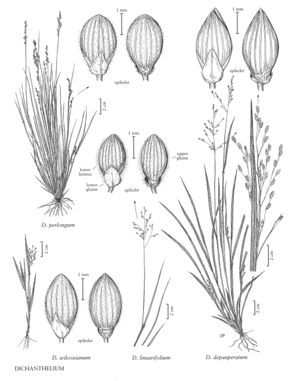Difference between revisions of "Dichanthelium perlongum"
FNA>Volume Importer |
imported>Volume Importer |
||
| (4 intermediate revisions by 2 users not shown) | |||
| Line 7: | Line 7: | ||
|synonyms={{Treatment/ID/Synonym | |synonyms={{Treatment/ID/Synonym | ||
|name=Panicum perlongum | |name=Panicum perlongum | ||
| − | |authority= | + | |authority= |
| + | |rank=species | ||
}} | }} | ||
|hierarchy=Poaceae;Poaceae subfam. Panicoideae;Poaceae tribe Paniceae;Dichanthelium;Dichanthelium sect. Linearifolia;Dichanthelium perlongum | |hierarchy=Poaceae;Poaceae subfam. Panicoideae;Poaceae tribe Paniceae;Dichanthelium;Dichanthelium sect. Linearifolia;Dichanthelium perlongum | ||
| Line 19: | Line 20: | ||
-->{{Treatment/Body | -->{{Treatment/Body | ||
| − | |discussion=<p>Dichanthelium perlongum grows in dry to mesic prairies, and is restricted to the Flora region. It appears to hybridize occasionally with D. depauperatum and D. linearifolium. The primary panicles are briefly open-pollinated and develop from May to early June; the secondary panicles are cleistogamous and are produced from mid-June through mid-July.</p><!-- | + | |discussion=<p><i>Dichanthelium perlongum</i> grows in dry to mesic prairies, and is restricted to the Flora region. It appears to hybridize occasionally with <i>D. depauperatum</i> and <i>D. linearifolium</i>. The primary panicles are briefly open-pollinated and develop from May to early June; the secondary panicles are cleistogamous and are produced from mid-June through mid-July.</p><!-- |
| − | --><p>Dichanthelium perlongum is similar to D. wilcoxianum, but differs in having only the upper 1 or 2 blades greatly elongated (usually more than 20 times longer than wide), narrow, erect basal blades, and a contracted panicle with ascending branches. Dichanthelium acuminatum also may also be confused with D. perlongum only if its upper internodes elongate, as tends to be the case after a spring fire, but D. acuminatum has less turgid spikelets and hairs in the ligule area that are 3-5 mm long.</p> | + | --><p><i>Dichanthelium perlongum</i> is similar to <i>D. wilcoxianum</i>, but differs in having only the upper 1 or 2 blades greatly elongated (usually more than 20 times longer than wide), narrow, erect basal blades, and a contracted panicle with ascending branches. <i>Dichanthelium acuminatum</i> also may also be confused with <i>D. perlongum</i> only if its upper internodes elongate, as tends to be the case after a spring fire, but <i>D. acuminatum</i> has less turgid spikelets and hairs in the ligule area that are 3-5 mm long.</p> |
|tables= | |tables= | ||
|references= | |references= | ||
| Line 29: | Line 30: | ||
-->{{#Taxon: | -->{{#Taxon: | ||
name=Dichanthelium perlongum | name=Dichanthelium perlongum | ||
| − | |||
|authority=(Nash) Freckmann | |authority=(Nash) Freckmann | ||
|rank=species | |rank=species | ||
| Line 36: | Line 36: | ||
|basionyms= | |basionyms= | ||
|family=Poaceae | |family=Poaceae | ||
| − | |illustrator=Linda A. Vorobik | + | |illustrator=Linda A. Vorobik;Hana Pazdírková |
| + | |illustration copyright=Utah State University | ||
|reference=None | |reference=None | ||
|publication title= | |publication title= | ||
|publication year= | |publication year= | ||
|special status= | |special status= | ||
| − | |source xml=https:// | + | |source xml=https://bitbucket.org/aafc-mbb/fna-data-curation/src/200273ad09963decb8fc72550212de541d86569d/coarse_grained_fna_xml/V25/V25_1218.xml |
|subfamily=Poaceae subfam. Panicoideae | |subfamily=Poaceae subfam. Panicoideae | ||
|tribe=Poaceae tribe Paniceae | |tribe=Poaceae tribe Paniceae | ||
Latest revision as of 17:56, 11 May 2021
Plants densely cespitose. Basal rosettes poorly developed; sheaths 2-4 cm; blades similar in shape to the lower cauline blades, narrow, ascending. Culms 10-50 cm, erect, lower 3-6 internodes telescoped together, forming a slender 2-4 cm column, upper 2 internodes elongated; nodes bearded; internodes puberulent and pubescent; fall phase with sterile branches arising near ground level and foreshortened reproductive branches arising from the higher nodes, secondary panicles small and narrow, enclosed within the sheaths, with 5-10 spikelets. Cauline leaves 2-4; sheaths longer than the internodes, pilose; ligules about 0.5 mm; blades 5-20 cm long, 1-3.5 mm wide, stiffly erect, long-tapering, sometimes involute, green or grayish-green, pubescent to pilose, upper 2 or 3 blades much longer than those below. Primary panicles 3-8 cm long, 1-3 cm wide, narrowly ellipsoid, long-exserted, with 12-25 spikelets; branches ascending; pedicels 2-4 mm, appressed. Spikelets 2.6-3.4 mm long, 1-1.7 mm wide, ellipsoid-obovoid, turgid, finely pubescent. Lower glumes 1-1.4 mm, broadly ovate; upper glumes and lower lemmas exceeding the upper florets by 0.2-0.3 mm before flowering, slightly pointed at maturity, upper florets obovoid, 1.9-2.7 mm, minutely umbonate. 2n = 18.
Discussion
Dichanthelium perlongum grows in dry to mesic prairies, and is restricted to the Flora region. It appears to hybridize occasionally with D. depauperatum and D. linearifolium. The primary panicles are briefly open-pollinated and develop from May to early June; the secondary panicles are cleistogamous and are produced from mid-June through mid-July.
Dichanthelium perlongum is similar to D. wilcoxianum, but differs in having only the upper 1 or 2 blades greatly elongated (usually more than 20 times longer than wide), narrow, erect basal blades, and a contracted panicle with ascending branches. Dichanthelium acuminatum also may also be confused with D. perlongum only if its upper internodes elongate, as tends to be the case after a spring fire, but D. acuminatum has less turgid spikelets and hairs in the ligule area that are 3-5 mm long.
Selected References
None.
